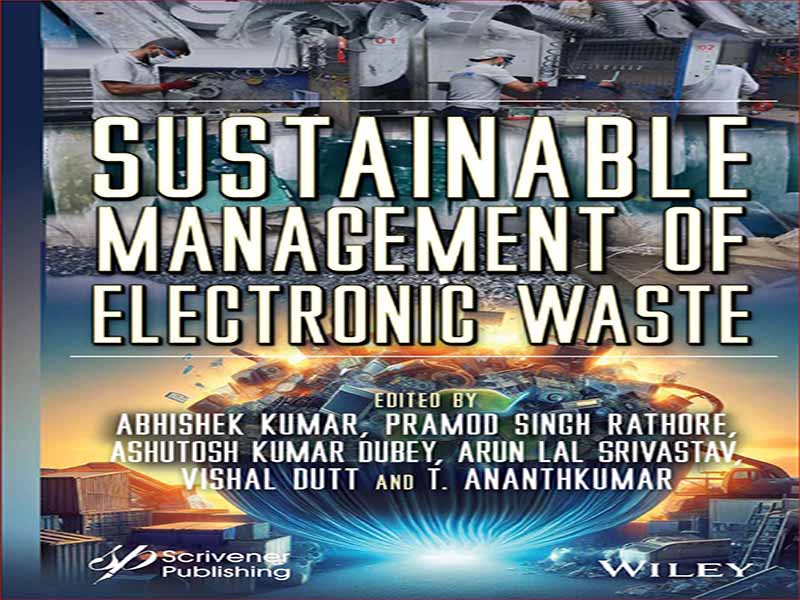- عنوان کتاب: Sustainable Management of Electronic Waste
- نویسنده: Abhishek Kumar
- حوزه: پسماند
- سال انتشار: 2024
- تعداد صفحه: 445
- زبان اصلی: انگلیسی
- نوع فایل: pdf
- حجم فایل: 32.2 مگابایت
این کتاب در نوزده فصل تنظیم شده است. در فصل 1، یک مطالعه به بررسی آثار منتشر شده هوش مصنوعی با EMS، RES و SG، اثرات و دلایل آنها میپردازد. فناوری هوش مصنوعی در چند دهه اخیر به سرعت تکامل یافته است و کاربردهای آن به سرعت در سیستم های صنعتی مدرن افزایش یافته است. به طور مشابه، سیستمهای الهامگرفته از طبیعت و زیستشناختی منبع الهام نامحدودی برای توسعه سیستمهای فنی هستند که پیشرفت تمدن بشری را هدایت میکنند و سبک تفکر ما را شکل میدهند. در فصل 2، نویسنده مفهوم پیشرفت هوش مصنوعی و فناوری بلاک چین را معرفی می کند که چشم اندازها را به سمت دقت بازاریابی حرارتی باز می کند. شبکه عصبی مصنوعی (ANN) برای بهبود تحقیقات پیشبینی انرژی زیست توده حیاتی است. این مطالعه بر مراحل مدلسازی و استفاده از ANN در پیشبینی مقادیر حرارتی زیست توده تأکید دارد. چندین شکاف تحقیقاتی در وضعیت فعلی تحقیق در ANN، از نظر زیست توده و راهنمایی برای تحقیقات بیشتر، شناسایی شدهاند. فصل 3 همچنین به نگرانیهای زیستمحیطی فزاینده در مورد استفاده و کاهش منابع سوخت تجدید ناپذیر، همراه با افزایش قیمت نفت و بیثباتی در بازارهای نفت، که اخیراً علاقه به تولید منابع انرژی پایدار در قالب سوختهای زیستی را برانگیخته است، خواهد پرداخت. مشتق شده از گیاهان اتانول تولید شده از زیست توده لیگنوسلولزی دارای مزایای مشخصه ای از نظر ایمنی، اقتصادی و سازگاری با محیط زیست نسبت به سوخت های فسیلی است. مواد لیگنوسلولزی شامل 50 درصد سلولز، 25 درصد همی سلولز و 25 درصد لیگنین است. در فصل 4، یک رویکرد جدید برای سیستم مدیریت انرژی خانه هوشمند برای پیشبینی مصرف انرژی با استفاده از الگوریتم یادگیری ماشین رگرسیون خطی بیزی پیشرفته (EBLRML) پیشنهاد شده است. مجموع باقیمانده مربع ها تفاوت مدل خطی قابل توجهی را از کاربرد موجود تکنیک های ML نشان می دهد که در آن ضریب بر اساس همبستگی کمتر است و مصرف انرژی برای دستیابی به بهترین مدل برازش محاسبه می شود. در فصل 5، نویسنده توضیح میدهد که امروزه استفاده از هوش مصنوعی تمام محدودیتهای ذکر شده در بیانیههای مشکل بالا را بهبود میبخشد. الگوریتمهای یادگیری ماشینی برای پیشبینی کشت محصول، معیارهای بهینهسازی، سطوح آبیاری و غیره استفاده شدهاند، اما برای پیشبینی آبوهوا و پیشبینی کشاورزی کار بسیار کمی انجام شده است. با استفاده از حسگرهای پیشرفته متصل به یک شبکه، می توان آب و هوای بدی را که ممکن است خود کشاورزی را در مراحل اولیه تهدید کند، شناسایی کرد. ویژگی های یک مزرعه زنده می تواند بهره برداری محصول را زودتر در چرخه رشد بهبود بخشد. در فصل 6، نویسنده توضیح می دهد که مصرف انرژی به طور تصاعدی افزایش یافته است و به شرکت های برق فشار می آورد تا تولید انرژی را افزایش دهند. یکی از نگرانیهای مهم روز کنونی این است که سیستمهای حفاظت و پایش انرژی برای بهینهسازی افزایش تقاضا برای انرژی و مصرف آن توسعه یافتهاند. سیستم های مدیریت انرژی به کاهش مصرف فعلی، جلوگیری از اتلاف انرژی و امکان استفاده بهینه از منابع موجود کمک می کند. در فصل 7، نویسنده یک مانع مهم در پذیرش گسترده این منابع انرژی در هزینه های بالای یکپارچه سازی آنها را توضیح می دهد. با این حال، توضیحات هوش مصنوعی (AI) و تخصص فشرده داده در حال حاضر در بخشهای مختلف زنجیره اهمیت الکتریکی به کار گرفته شدهاند و با توجه به پیچیدگی روزافزون شبکه هوشمند آینده و ظرفیت تولید داده، این احتمال وجود دارد که ارزش قابلتوجهی به سیستم اضافه کند. فصل 8 توضیحات مفصلی در مورد مسائل مهمی که بر کل زنجیره ارزش زباله الکترونیکی هند تأثیر میگذارند، از جمله فقدان موجودیسازی دادهها، دفع غیرقانونی و انتخابهای درمانی ارائه میدهد. در نتیجه، این مطالعه بر مداخلات استراتژیک که با قوانین موجود مطابقت دارد و برای زنجیره ارزش زباله های الکترونیکی طولانی مدت، منابع ایمن، رفاه اجتماعی، کاهش پیامدهای زیست محیطی و به طور کلی توسعه پایدار ضروری است، تمرکز دارد. جدای از این ها، روش های دیگری برای بازیافت زباله های الکترونیکی نیز برای حفظ یکپارچگی محیط زیست گنجانده شده است. فصل 9 نگرانی های زیست محیطی مرتبط با تجهیزات الکترونیکی دور ریخته شده را که گاهی اوقات به عنوان زباله الکترونیکی شناخته می شود، به تفصیل مورد بحث قرار می دهد. علاوه بر این، توسعه زباله های الکترونیکی چه در حال حاضر و چه در آینده، و همچنین هرگونه مشکل زیست محیطی که ممکن است از رویکردهای مدیریت و دفع آن ناشی شود، بررسی شده و برنامه های موجود برای مدیریت زباله های الکترونیکی مورد بحث قرار گرفته است.
This book is organized into nineteen chapters. In Chapter 1, a study explores the published works of AI with EMS, RES, and SG, their effects, and their reasons. AI technology has evolved quickly in the last several decades, and its applications have rapidly increased in modern industrial systems. Similarly, nature-inspired and biological systems denote an unlimited inspiration source for developing technical systems that lead human civilization’s progress and shape our thinking style. In Chapter 2, the author introduces the concept of the progress of artificial intelligence and blockchain technology unlocking prospects toward thermal marketing accuracy. The Artificial Neural Network (ANN) is crucial for improving biomass energy prediction research. This study emphasizes the steps in modeling and using ANN in forecasting biomass thermal values. Several research gaps in the present state of the investigation on ANN, in terms of biomass and guidance for additional research, are identified. Chapter 3 will also go over growing environmental concerns over the use and depletion of non-renewable fuel sources, together with the increasing price of oil and instabilities in the oil markets, which have recently stimulated interest in producing sustainable energy sources in the form of biofuels derived from plants. Ethanol developed from lignocellulosic biomass has characteristic benefits of safety, economics, and being more environmentally friendly than fossil fuels. The lignocellulosic materials comprise 50% cellulose, 25% hemicellulose, and 25% lignin. In Chapter 4, a novel approach for a Smart Home Energy Management System for Energy Consumption Prediction is proposed using an Enhanced Bayesian Linear Regression Machine Learning algorithm (EBLRML). The residual sum of squares shows the significant linear model difference from the existing application of ML techniques where the coefficient based on correlation is lower, and the energy consumption is calculated to achieve the best-fit model. In Chapter 5, the author explains that using artificial intelligence today improves all the limitations outlined in the problem statements above. Machine learning algorithms have been used to predict crop cultivation, optimization metrics, irrigation levels, and so on, but very little has been done to predict weather and forecast agriculture. By using advanced sensors connected to a network, it is possible to identify bad weather that may threaten agriculture itself at an earlier stage. A live farm’s features can improve crop exploitation earlier in the growing cycle. In Chapter 6, the author explains that energy consumption has risen exponentially, putting pressure on the utilities to increase energy production. One of the significant concerns of the current day is that energy conservation and monitoring systems have been developed to optimize the increasing demand for energy and its consumption. Energy management systems help to decrease current consumption, prevent energy wastage, and enable the optimized utilization of available resources. In Chapter 7, the author explains a significant impediment to the widespread adoption of these energy sources in their high integration costs. However, artificial intelligence (AI) explanations and data-intensive expertise are currently being deployed in various sectors of the electrical significance chain and, given the future smart grid’s increasing complexity and data generation capacity, have the probability of adding substantial value to the system. Chapter 8 provides detailed explanations of critical issues influencing India’s entire e-waste value chain, including a lack of data inventorization, unlawful disposal, and treatment choices. As a result, this study focuses on strategic interventions that comply with existing legislation and are necessary for a long-term e-waste value chain, secure resources, social well-being, reduced environmental consequences, and overall sustainable development. Apart from these, other methods for recycling e-waste are also incorporated to maintain the environment’s integrity. Chapter 9 discusses the environmental concerns linked with discarded electronic equipment, sometimes known as “e-waste,” in detail. In addition, the development of e-waste both now and in the future, as well as any environmental difficulties that may come from its management and disposal approaches, are investigated, and the existing programs for the management of e-waste are discussed.
این کتاب را میتوانید از لینک زیر بصورت رایگان دانلود کنید:


































نظرات کاربران